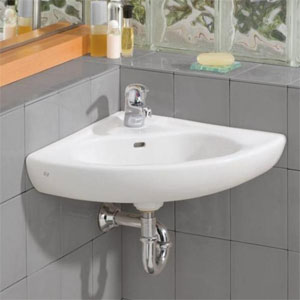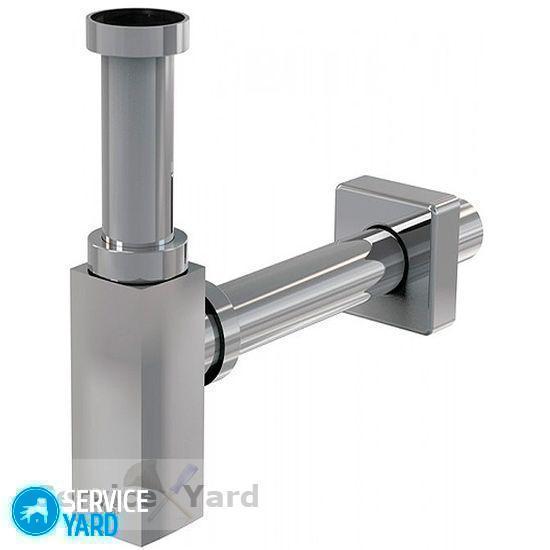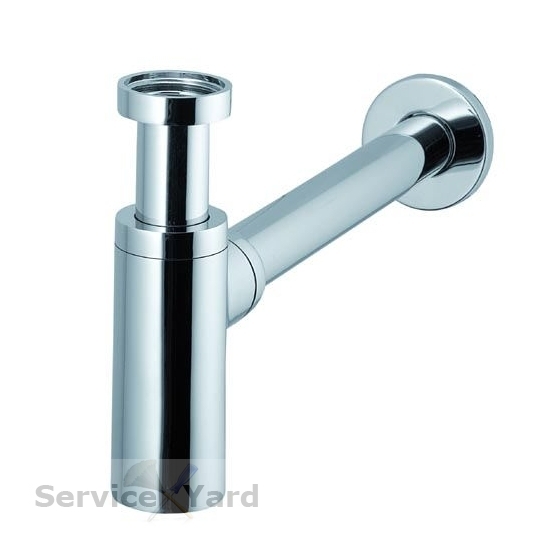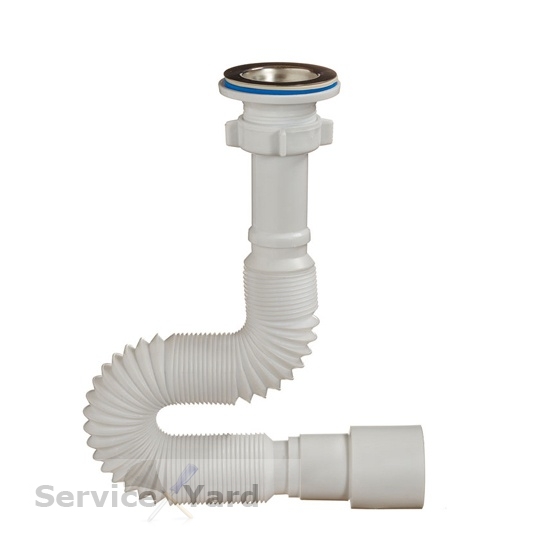Pipe under the sink

A bent pipe under the sink is called a siphon. The main purpose of this plumbing element is to prevent sewage gases from entering the room. Many believe that connecting plumbing is an incredibly complex process and is available only to specialists. In fact, anyone can do this job. It is only necessary to find out which siphon for the sink to choose, and how this important part of the sewer system is installed.
to contents ↑A variety of siphons
At its core, the siphon is a curved pipe under the sink, in the knee of which there is water, which acts as a water seal. Practically all devices connected to the sewerage are supplied with such sanitary elements. Therefore, if you plan to replace the washbasin or other plumbing, then the siphon must also be replaced.
Important! On sale there are siphons for various plumbing:
- Toilet bowl.
- Sinks.
- Shower cabins.
- Bathtubs.
A bent pipe located under the sink can be seen in every kitchen. The siphon performs the following functions:
- Through the knee, wastewater enters the sewers.
- Siphon prevents odors from the sewer.
 The design of the sink siphon varies depending on its type. The designs are as follows: bottle, corrugated or pipe.
The design of the sink siphon varies depending on its type. The designs are as follows: bottle, corrugated or pipe.
Trumpet
Such models are often used for bathtubs, but they are also sometimes installed under the sink. The siphon is a bent pipe in the form of the letter “U” or “S”. Such pipes under the sink were very common in Soviet times, when the drain was made from cast-iron pipes. This is a fairly simple siphon model, however, it is more difficult to install it than other types of pipes, because unlike a corrugation, it does not stretch.
Important! The disadvantages of the model:
- Dimensions It takes up a lot of space.
- It can only be cleaned from large debris.
So if you need a small siphon for the sink, then choose a different model.
Siphon Corrugation
This type of pipe under the sink resembles the previous design, but the drain is soft and pleated. The zigzag bend is fixed with a plastic clamp.
Advantages of this type:
- Mobility. Allows you to move the sink over short distances.
- The minimum number of joints, and therefore, reduces the risk of leaks.
- Easy installation. The corrugated pipe is well stretched and bent, so you will not have difficulty connecting a siphon, even if you need to move the sink from its original location.
- Low price.
Important! Disadvantages of the corrugated pipe under the sink:
- Corrugated surface that quickly clogs with fat.
- To clean the corrugated siphon, you will need to completely dismantle it.
Bottle
The design got its name because of the shape resembling a bottle. This is the most common type of knee for a sink. The plumbing element has a flask that performs the function of a sump. The discharge pipe is located inside the flask, due to this design a water lock is formed. If necessary, it is easy to unwind and clean the pipe, so if you accidentally drop a ring or other object into the drain hole, it is easy to get it out by unscrewing the lid of the sump.
The advantages of this model include:
- Possibility to additionally attach a branch pipe to the siphon.This property can be used when connecting the drain hose from the washing machine.
- The ability to clean the siphon without removing it completely.
Important! The disadvantages of the model include a large number of compounds, which means that there is a likelihood of leakage.
Other pipe options under the sink
On sale you can find combined models:
- Bottle type siphon equipped with a corrugated pipe for connection to the sewer.
- Double siphon, if the sink has two bowls, or siphons with a branch pipe for connection to the washing machine.
- Designs with automatic drain and overflow hole. Such designs allow you to draw water into the sink, and then, if necessary, lower it by pressing a single button. Such products are used much less frequently.
How to choose a siphon?
There are different types of siphons on sale, so you need to choose the most suitable.
Material
First of all, determine the material for the pipe under the sink:
- Metal. Plumbing elements are made of cast iron, as well as alloys of brass and bronze. The metal version of the siphon is more expensive, and mounting a metal siphon is much more difficult than plastic.
- Plastic. Great siphon option. Cheap and practical. In operation, it is quite durable, not susceptible to corrosion, easy to install, and will last quite a long time.
Appearance
 When choosing a siphon, decide whether the plumbing element will be located openly or “hide” in the cabinet or in the pedestal of the sink. If the siphon is in sight - pick up a decorative model. It can be an element of non-ferrous metal, or a chrome version. If the siphon is hidden, then give preference to the simplest plastic models.
When choosing a siphon, decide whether the plumbing element will be located openly or “hide” in the cabinet or in the pedestal of the sink. If the siphon is in sight - pick up a decorative model. It can be an element of non-ferrous metal, or a chrome version. If the siphon is hidden, then give preference to the simplest plastic models.
Functionality
Depending on the model of the sink and the intended use of the siphon, consider the availability of additional equipment. For example:
- if the washbasin has a hole for overflow, then the pipe under the sink should be appropriate;
- if you need to connect the drain from the washing machine to the siphon, then select the option with an additional nozzle.
Section
Be sure to pay attention to the bandwidth of the model. It should be taken into account depending on the planned volume of effluents. For example, if the model's throughput rate is low, then the siphon will not cope with the incoming drains, and a “flood” may form in the bathroom.
to contents ↑Important! When buying a siphon, be sure to check its configuration, since you can not count the gaskets or get two flat ones instead of the necessary cone.
How to replace the siphon?
Installing a corrugated siphon is much easier than a bottle design, as it has much less detail. In fact, the main element is a corrugated pipe, so installation is reduced to the fact that one end of the pipe is connected to the sink, and the other to the sewer. Nuts and sealing washers fix the whole structure, and bend the pipe with a plastic clamp.
In more detail we will consider the installation instructions for plastic bottle siphons.
Training
If you need to dismantle the old siphon, proceed as follows:
- Turn off the water supply.
- Place a bucket under the old siphon. Dirty water flowing from a pipe will collect in it.
- Unscrew and remove the sump glass of the sanitary element.
- Disassemble the connection at the sink drain.
- Remove all gaskets.
- Disconnect the pipe from the sewer.
Kit Check
Before starting the installation of the plastic siphon, check its configuration. The design should include:
- Outlet pipe. The part is made of plastic and a metal threaded part pressed into it.
- Siphon body.
- Plastic nuts.
- Tightening screw used to fasten the decorative grille.
Important! The most practical model is one in which the coupling screw is made of stainless steel.
- Decorative steel overlay for drain hole.
- Gaskets:
- 3-5 mm thick rubber gasket worn on the exhaust pipe.
- Rubber conical cuff. Used when connecting the outlet to the body.
- Rubber decorative strip in white. It is installed on the drain hole on the front side.
- A rubber ring gasket that fits over the bottom of the siphon.
Important! Other items can be included in the package, for example, a stopper for closing a drain hole of a sink and another.
Siphon mounting
Installation must be carried out in accordance with the manufacturer's instructions. Each model comes with assembly instructions with a detailed diagram.
 The general scheme of how the pipe is installed under the sink looks like this:
The general scheme of how the pipe is installed under the sink looks like this:
- Check the fit of the grill at the sink drain hole. If the grate is located too high, the water will not go to the end, which means that puddles will form around the drain hole. A normally installed grill should be slightly “recessed”.
- Install a thick rubber cuff in the outlet pipe (pre-lubricate it with sealant).
- Check thread surface on parts. If agnails or breaks are noticed, remove defects with a sharp knife.
- In the sink, install the grill with the white gasket.
- On the back of the sink, attach the outlet pipe. Tighten the locking screw.
- Insert a gasket into the groove of the sump body.
- Screw the bottom of the glass to the top.
- Put the plastic coupling nut on the exhaust pipe first and then the cone gasket (the distance between the gasket and the edge of the pipe should be 3-5 mm).
- Insert the nozzle into the siphon flask and tighten the nut (tighten the nut by hand, as you can easily pull it with a wrench, and this will damage the siphon).
Important! The pipe should not be fully inserted into the wall. Otherwise, the water will simply have nowhere to go.
- If there is a branch pipe on the siphon body for connecting the drain from the washing machine, then install a plug on it, since it will not be activated yet.
- Attach a rigid or corrugated discharge pipe to the siphon body.
- Connect the exhaust pipe to the sewer socket.
Important! If during installation the diameter of the parts does not match, then use transitional connecting cuffs made of rubber.
- Check build quality: turn on water at full power. If the connection is made qualitatively, then drops will not be noticed on the floor.
Siphon Repair
If you notice that a pipe is flowing under the sink, and a siphon is not expected to be replaced, then try to repair the old model yourself. As a rule, a leak occurs at the joints (if there is no mechanical damage to the pipes).
On bottle models, leakage may occur at the attachment point of the sump. To fix the problem:
- Separate the parts at the location of the defect.
- Remove the gasket.
- Dry all parts.
- Apply a coat of sealant.
- Reinstall the gasket in its original place.
- Apply sealant again.
- Apply sealant to the threads.
- Tighten the connections.
- Turn on the water and check the quality of work.
to contents ↑Important! If the siphon is leaking, replace the gasket with a new one if possible. In case of serious damage, replace the siphon.
Helpful hints:
- When sealing plumbing equipment, additionally “reel” the thread, especially in cases where a loose fit is observed. Use tow or silicone special tape - wrap them on threads to improve tightness. The nut, at the same time, should go tight.
- During operation, regularly care for the siphon. If it is necessary to pour dirty water into the sink, be sure to install a strainer on the drain hole that will prevent large particles from entering the siphon.
- The sink must always be used so that there is always water in the siphon.If you plan to leave for a long time, pour oil or glycerin into the sink so that the water in the siphon does not evaporate.
Stock footage
We hope that our advice, recommendations will help you choose the right model of pipe under the sink, install it correctly and provide proper care. As a result, such a necessary sanitary element will last you a long time and will not require replacement.
- How to choose a vacuum cleaner taking into account the characteristics of the house and coatings?
- What to look for when choosing a water delivery
- How to quickly create comfort at home - tips for housewives
- How to choose the perfect TV - useful tips
- What to look for when choosing blinds
- What should be running shoes?
- What useful things can you buy in a hardware store
- Iphone 11 pro max review
- Than iPhone is better than Android smartphones



